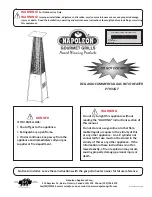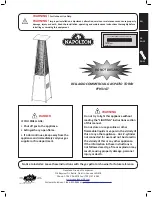
1. Do not attempt to install, repair, or service this heater
or the gas supply line unless you are authorized and
have continuing expert training and knowledge of gas
heaters.
a. To be an authorized gas heater service person, you
must have sufficient training and experience to
handle all aspects of gas-fired heater installation,
service and repair. This includes the task of
installation, troubleshooting, replacement of
defective parts and testing of the heater. You must
be able to place the heater into a continuing safe
and normal operating condition. You must
completely familiarize yourself with each model
heater by reading and complying with the safety
instructions, labels, Owner’s Manual, etc., that is
provided with each heater.
b. To be a authorized gas installation person, you
must have sufficient training and experience to
handle all aspects of installing, repairing and
altering gas lines, including selecting and installing
the proper equipment, and selecting proper pipe
and tank size to be used. This must be done in
accordance with all local, state and national codes
as well as the manufacturer’s requirements.
2. All installations and applications of L.B. White heaters
must meet all relevant local, state, regional and
national codes. Included are L.P. gas, natural gas,
electrical, and safety codes. Your local fuel gas
supplier, a local licensed electrician, the local fire
department or similar government agencies, or your
insurance agent can help you determine code
requirements.
3. Do not move, handle, or service heater while in
operation or connected to a power or fuel supply.
4. The heater is approved for outdoor mounting only.
Therefore it will be exposed to inclement weather,
such as rain. However, the heater may also be washed
for cleaning if desired. This heater may only be
washed on the external case assembly—see Cleaning
Instructions. Do not wash the interior of the heater.
Use only compressed air, soft brush or dry cloth to
clean the interior of the heater and it’s components.
5. For safety, this heater is equipped with a manual reset
high-limit switch and an air flow switch. Never operate
this heater with any safety device that has been
bypassed. Do not operate this heater unless these
features are fully functioning.
6. Do not operate the heater with its door open or panel
removed.
7. Do not locate fuel gas containers or fuel supply hoses
within 6,10 meters of the blower outlet of the heater
.
8. Do not block air intakes or discharge outlets of the
heater. Doing so may cause improper combustion or
damage to heater components leading to property
damage or animal loss.
9. Gas hose requirements:
-- Where a hose assembly is used to install this
appliance, only a hose certified in accordance with
AS/NZS1869 shall be used.
-- The hose assembly shall be visually inspected
on a daily basis.
-- If it is evident there is excessive abrasion or wear, if
the hose is cut,or if the gas hose fittings are
stripped or corroded, it must be replaced prior to
the heater being put into operation
-- The hose assembly shall be protected from animals,
building materials, and contact with hot surfaces
during use.
10. Check for gas leaks and proper function upon heater
installation, before building repopulation, or when
relocating.
11. This heater should be inspected for proper operation
by a qualified service person before building
repopulation and at least annually.
12. Always turn off the gas supply to the appliance if the
appliance is not going to be used in the heating of
livestock.
13. The heater is wired for a three-wire electrical system.
There is a hot lead, neutral lead, and a ground lead.
The power cord may or may not incorporate a plug and
the plug may or may not incorporate a pin for the
ground wire. In any case, the heater must be properly
connected into a grounded electrical supply using the
ground lead in the power cord. Failure to use a
properly grounded electrical supply can result in
electrical shock, personal injury, or death.
14. Direct spark ignition heaters will make up to three
trials for ignition. If ignition is not achieved after the
third trial, the control system will “lock out” the gas
control valve. If gas is smelled after system lock out
has occurred, immediately close all fuel supply valves.
Do not relight until you are sure that all gas that may
have accumulated has cleared away. In any event, do
not relight for at least 5 minutes.
15. When mounted outside, rigid pipe or copper tubing
coupled directly to the heater may cause gas leaks
during any vibration and therefore must not be used.
Use only gas hose assemblies that are rated and
approved for L.P. gas and natural gas.
6
Safety Precautions







































